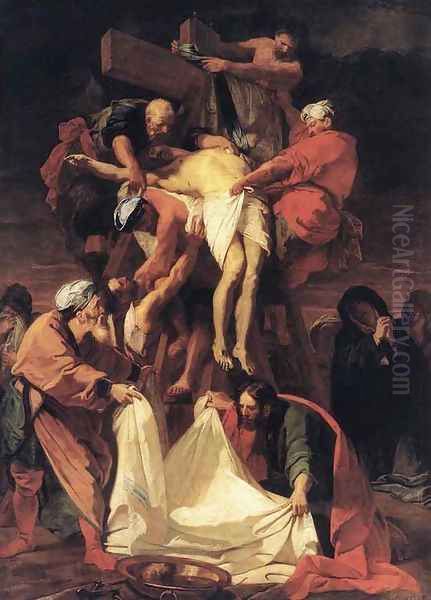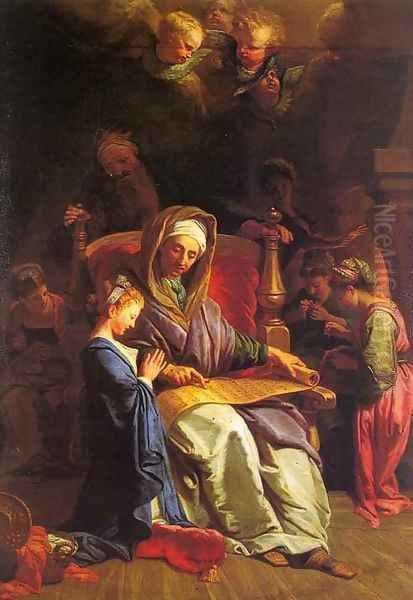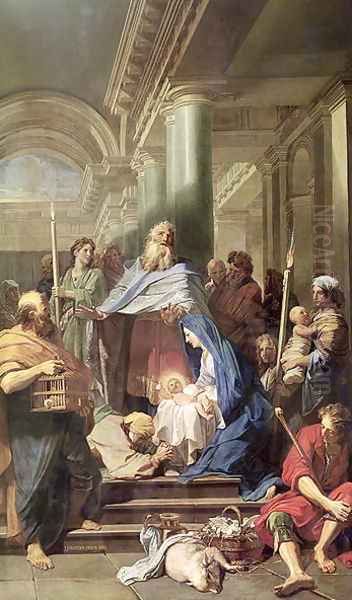Introduction: An Artist Born into Art

Jean-Baptiste Jouvenet, born in Rouen, Normandy, in 1644, emerged as one of the most significant French painters of the late Baroque period. His life, spanning from the height of Louis XIV's reign into the early 18th century, was dedicated to art, particularly large-scale religious compositions that adorned churches and palaces across France. Jouvenet hailed from a veritable dynasty of artists; his father, Laurent Jouvenet, was a painter and sculptor, and earlier generations, including his great-grandfather Noël Jouvenet, were also artists. Some accounts even suggest Noël may have been an early teacher to the great Nicolas Poussin, embedding the Jouvenet name deep within the narrative of French art history. Jean-Baptiste would not only continue this legacy but elevate it, becoming a central figure in the artistic establishment of his time. He died in Paris on April 5, 1717, leaving behind a substantial body of work that continues to command respect.
Early Life and Artistic Formation in Rouen
Growing up in Rouen, a city with its own rich artistic traditions, Jean-Baptiste received his initial training from his father, Laurent. The environment was undoubtedly steeped in the practice and discussion of art. This familial apprenticeship provided a solid foundation in the fundamentals of drawing and painting. Even in his youth, Jouvenet reportedly displayed remarkable talent, quickly absorbing the lessons offered within his family circle. The artistic lineage provided not just instruction but likely connections and an inherent understanding of the art world, preparing him for the challenges and opportunities that lay beyond his native Normandy. His innate abilities, nurtured in this environment, soon necessitated a move to the center of the French art world.
Arrival in Paris and the Influence of Charles Le Brun

Around the age of seventeen, circa 1661, Jouvenet made the pivotal decision to move to Paris. This was the epicenter of artistic activity in France, dominated by the powerful figure of Charles Le Brun. Le Brun was not merely a painter; he was the chief artistic arbiter for King Louis XIV, Director of the Royal Academy of Painting and Sculpture, and head of the Gobelins Manufactory. Jouvenet entered Le Brun's bustling studio, a hub of talent responsible for executing the grand decorative schemes commissioned by the crown, most notably at the Palace of Versailles.
Working under Le Brun was a formative experience. Jouvenet quickly distinguished himself among the many assistants and pupils. Le Brun recognized his talent, entrusting him with significant responsibilities. This period exposed Jouvenet to the 'Grand Manner' of painting favoured by the Academy – characterized by historical or religious subjects, clear compositions, idealized forms, and a didactic purpose. He absorbed Le Brun's methods for organizing large-scale compositions and managing a studio, skills that would prove invaluable throughout his career.
Ascendancy within the Royal Academy and Royal Patronage
Jouvenet's talent and diligence did not go unnoticed within the formal structures of the French art world. In 1673, his painting Saint Peter Healing the Sick with his Shadow was selected as the prestigious 'May' painting for Notre Dame Cathedral, a commission awarded annually by the goldsmiths' guild, signalling his arrival as a significant religious painter. His official recognition came in 1675 when he was received as a full member of the Académie Royale de Peinture et de Sculpture. His reception piece, likely Esther before Ahasuerus, demonstrated his mastery of the required historical genre.
His career within the Academy progressed steadily. He was appointed an assistant professor, then elected Professor in 1681. His standing continued to rise, culminating in his appointment as Director in 1705 and, significantly, as one of the four perpetual Rectors in 1707, a position of considerable influence. This academic success paralleled his continued involvement in royal projects. He contributed to the decorations at the Palace of Versailles, working alongside other Le Brun protégés like René-Antoine Houasse and Claude Audran III in spaces such as the Salon de Mars. He also received commissions for other royal residences, including the Grand Trianon.
The Jouvenet Style: A Synthesis of Power and Piety
Jouvenet's artistic style represents a compelling synthesis of prevailing trends. Rooted in the French classicism championed by Le Brun and influenced by the compositional clarity of Nicolas Poussin, his work possesses a distinct character. He infused the often-formal academic style with a greater dynamism, emotional intensity, and richness of colour, drawing inspiration from Flemish Baroque masters, particularly Peter Paul Rubens. This is evident in the swirling movement, dramatic lighting, and robust figures that populate many of his canvases.

While adhering to the principles of decorum and clarity expected in religious art of the period, Jouvenet excelled at conveying genuine human emotion and psychological depth. His figures, though often idealized according to Baroque conventions, possess a tangible weight and presence. He combined meticulous attention to realistic detail – textures of fabric, expressions of faces, architectural settings – with a powerful sense of spiritual drama. This blend of Baroque energy, academic structure, and sincere piety distinguishes his work from both the stricter classicism of Poussin and the sometimes more purely decorative tendencies of the emerging Rococo. Influences from Italian painters like the Carracci brothers, Annibale and Agostino, and Domenichino, known for their religious pathos, can also be discerned in his approach to sacred narrative.
Masterpieces of Religious Painting
Jouvenet's reputation rests primarily on his monumental religious paintings. The Miraculous Draught of Fishes, now housed in the Louvre Museum, is a prime example of his mature style. Created around 1706, it showcases his ability to handle a complex multi-figure composition with clarity and dramatic force. The swirling energy of the figures hauling the net contrasts with the calm authority of Christ. The rich colours and attention to the textures of water, fish, and fabric are remarkable. Anecdotally, Jouvenet is said to have travelled to the coastal town of Dieppe to study fishing scenes firsthand, ensuring the authenticity of the details. The work's popularity is attested to by the fine engraving made by Jean Audran.
Another major work, The Raising of Lazarus, also in the Louvre, exemplifies his talent for capturing moments of high spiritual drama. Commissioned for the church of Saint-Martin-des-Champs in Paris, the painting depicts the awe and astonishment surrounding Christ's miracle with palpable intensity. The interplay of light and shadow heightens the emotional impact, focusing attention on the central figures of Christ and the revived Lazarus. The varied reactions of the onlookers demonstrate Jouvenet's skill in rendering individual psychology within a large ensemble.
His Descent from the Cross, again in the Louvre, tackles a theme treated by countless masters before him, including Rogier van der Weyden and Rubens. Jouvenet brings his own sensibility to the subject, emphasizing the grief and tenderness of the figures lowering Christ's body. The composition is carefully structured, yet filled with pathos. The limpness of Christ's form and the sorrowful expressions of the Virgin Mary and surrounding disciples are rendered with moving sincerity.

Jouvenet also undertook significant decorative cycles with religious themes. His paintings of The Twelve Apostles for the pendentives supporting the dome of the Church of the Invalides in Paris (designed by the great architect Jules Hardouin-Mansart) required immense skill in adapting complex figural compositions to curved architectural spaces. These works contribute significantly to the grandeur and spiritual atmosphere of one of Paris's most important Baroque monuments. Other notable religious works include Christ Healing the Paralytic, The Adoration of the Trinity, The Education of the Virgin, and paintings depicting Jesus Driving the Money Changers from the Temple and Christ in the House of Simon the Pharisee.
Secular Decorations and Portraiture
While best known for his religious canvases, Jouvenet also contributed to secular decorative projects, primarily for royal and aristocratic patrons. His work at Versailles and the Grand Trianon involved mythological and allegorical subjects, executed in the grand style appropriate for palatial settings. He created works for the Parlement buildings in Rouen and Rennes, demonstrating his ability to adapt his style to civic contexts. One notable example of his mythological work is Apollo Presenting his Chariot to Thetis.
Portraiture formed a smaller, but still significant, part of Jouvenet's output. His Self-Portrait (Louvre) presents a confident image of the artist, meeting the viewer's gaze directly. He also painted portraits of contemporaries, such as the striking depiction of Doctor Raymond Finot (also Louvre), capturing the physician's intelligent and thoughtful demeanor. While perhaps lacking the sheer volume and fashionable flair of specialist portraitists like Hyacinthe Rigaud or Nicolas de Largillière, Jouvenet's portraits reveal a keen eye for likeness and character, rendered with the same solid technique evident in his larger compositions.
The Jouvenet Family: An Artistic Dynasty
Jean-Baptiste Jouvenet was the most famous member of a family deeply involved in the arts for several generations. His father, Laurent (1609–1681), was a respected painter and sculptor in Rouen. His younger brother, François Jouvenet (1664–1749), also became a painter, specializing primarily in portraits and, notably, still lifes, a genre Jean-Baptiste rarely touched. François's style shows the influence of his elder brother's robust realism. The artistic tradition continued into the next generation with Jean-Baptiste's nephews, Jean II Jouvenet and François II Jouvenet, ensuring the family name remained associated with painting in the 18th century. This strong familial context underscores the deep roots of Jouvenet's artistic identity.
Later Years: Triumph Over Adversity
Jouvenet's later career was marked by a significant personal challenge. In 1713, he suffered a stroke that left his right side paralyzed. For a painter, especially one accustomed to working on a large scale, this could have been a career-ending catastrophe. However, demonstrating remarkable resilience and determination, Jouvenet taught himself to paint with his left hand.
Astonishingly, he continued to produce significant works. His final 'May' offering to Notre Dame Cathedral, The Visitation (also known as the Magnificat), painted in 1716, was executed entirely with his left hand. This work stands as a powerful testament to his unwavering dedication to his art. Despite his physical limitations, he maintained the quality and scale of his compositions, adapting his technique as necessary. He remained an active and respected figure in the Parisian art world until his death.
International Connections: Peter the Great and Tapestry Design
Jouvenet's fame extended beyond the borders of France. He received a notable commission linked to Tsar Peter the Great of Russia. The Tsar, during his visit to Paris, admired Jouvenet's work and commissioned tapestry cartoons based on four of his major religious paintings: The Raising of Lazarus, Jesus Driving the Money Changers from the Temple, The Miraculous Draught of Fishes, and Christ in the House of Simon the Pharisee. These cartoons were intended for the Gobelins Manufactory to weave tapestries, which Peter the Great planned to present as a diplomatic gift to the young King Louis XV. This commission highlights Jouvenet's international reputation and the high esteem in which his religious narratives were held, considered suitable for both royal collections and diplomatic exchange.
Legacy and Historical Position
Jean-Baptiste Jouvenet occupies a crucial position in the history of French art. He was one of the last great exponents of the French Baroque 'Grand Style' inherited from Charles Le Brun, but he revitalized it with greater emotional depth and painterly vigour. He successfully navigated the demands of the powerful Royal Academy and secured prestigious commissions from both the Church and the Crown throughout his long career.
His influence extended to the next generation of French painters, particularly those specializing in religious subjects. His most notable pupil was his nephew, Jean Restout II (1692–1768), who carried forward Jouvenet's powerful style of religious painting into the mid-18th century. Jouvenet stands alongside contemporaries like Antoine Coypel and Charles de La Fosse as a leading figure who maintained the vitality of history painting in France during a period that would soon see the rise of the lighter, more intimate Rococo style. His ability to blend dramatic intensity with narrative clarity and convincing realism ensured his place as one of France's most accomplished and respected religious painters.
Conclusion: A Master of the Grand Narrative
Jean-Baptiste Jouvenet's life and work exemplify the dedication and skill required to succeed at the highest levels of the French art world during the Baroque era. Born into an artistic family, trained under the leading master Charles Le Brun, and rising through the ranks of the Royal Academy, he became a dominant force in religious painting. His monumental canvases, characterized by dynamic compositions, rich colour, dramatic lighting, and profound emotional resonance, adorned the churches and palaces of France. Even debilitating illness in his later years could not extinguish his creative drive. Jouvenet's legacy endures through his powerful narrative works, which remain compelling examples of French Baroque art, securing his position as a true master of the grand narrative tradition.